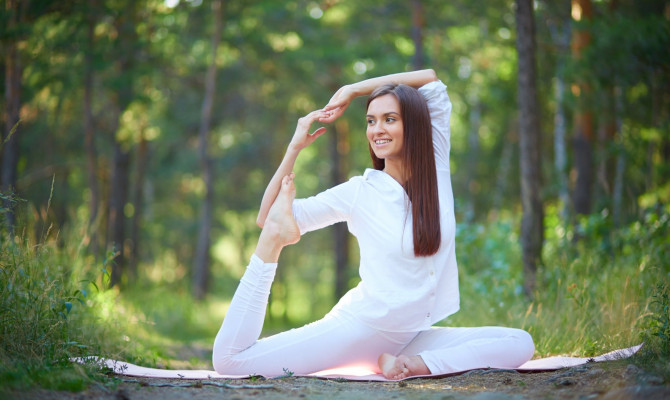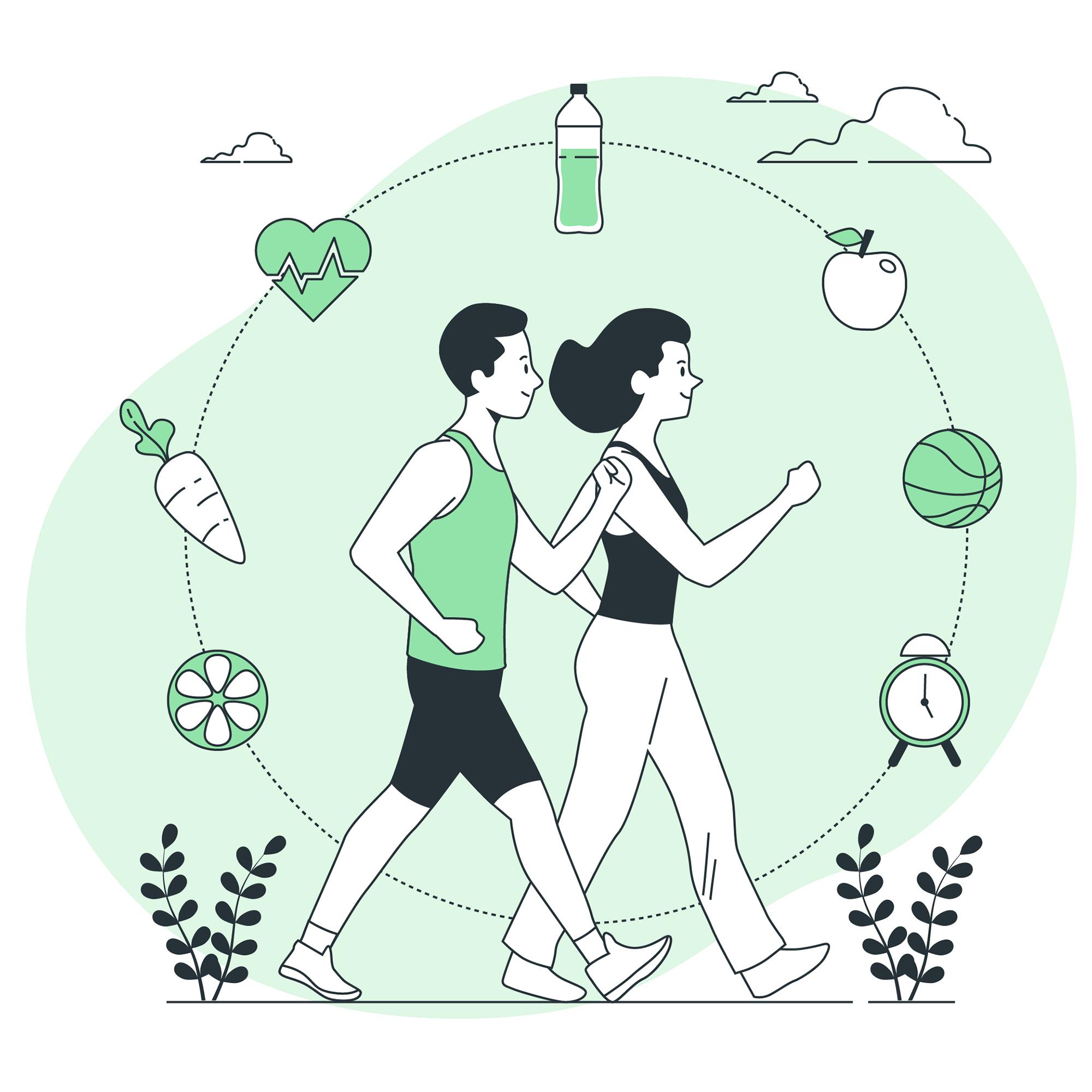All About Exercise : Types, Benefits and Risk

- Exercise
- 17 Aug 2023
Overview
About Exercise
In today’s fast-paced and sedentary lifestyle, neglecting our physical well-being is easy. But maintaining excellent health and general well-being requires regular physical activity. Exercise offers a plethora of benefits, both to physical and mental health including lowering a person’s likelihood of chronic diseases, elevating mood and boosting energy levels. In this article, we will explore the types of exercise, their numerous health benefits, the risks of a sedentary life, everyday exercise, and tips to make exercising a routine.

Types
Types of Exercise
There are various types of exercises one could do, including:
- Strength training
- Endurance
- Balance
- Flexibility
Strength training
- Also known as resistance training, it can involve lifting weights, one’s body weight, utilizing resistance bands, etc., and strengthening muscles1Types| Researched based study from Nia.nih.gov
- Maintaining strong muscles helps improve balance, reduce the risk of falling, and lessen the harm caused by falls.
Endurance exercise
- Also known as aerobic exercise, it is good for the heart, lungs, and circulatory system.
- These activities support people in maintaining their health and fitness as well as completing the daily duties they must complete
- Examples include dance, jogging, brisk walking, swimming, tennis, biking, etc2Types| Researched based study from Heart.org
Balance exercise
- Balance exercises prevent falls, a prevalent issue among older persons, and can have detrimental effects.
- Numerous lower-body strengthening activities will also help you balance better.
- Yoga, Pilates, Tai chi, are examples3Types| Researched based study from Mayoclinic.org
Flexibility
- Flexibility can be increased through stretching and is essential for avoiding injuries and may include lunges, ankle stretches, back stretches, etc.
- The muscles can better prepare for workout by stretching before working out.
- Stretching after an exercise is known to be even more important for preventing injuries. 4Types| Researched based study from Aaos.org
Health benefits

Health benefits of Exercise
The importance of exercising regularly can be explained by its numerous health benefits, including:
- Manages weight
- Reduces pain
- Increases energy and stamina
- Improves sleep quality
- Boosts mental health
- Improves skin health
- Prevents diseases
- Improves bone health
- Promotes heart health
- Relieves stress
- Promotes sex life
- Improves brain function
- Increases longevity
Manages weight
- Maintaining a nutritious diet and practicing regular physical exercise is essential to manage weight5Health benefits| Researched based study from Cdc.gov
- Exercise contributes to maintaining a healthy weight by helping the body burn calories and develop muscle.
Reduces pain
- People with chronic pain can benefit from regular exercise by feeling less pain and having better physical function6Health benefits| Researched based study from Nlm.nih.gov
Increases energy and stamina
- Regular exercise improves endurance and stamina and gives people more energy naturally.
- It enhances the flow of oxygen and nutrients to tissues, easing daily chores and reducing tiredness7Health benefits| Researched based study from Mayoclinic.org
Improves sleep quality
- By lowering stress and anxiety levels, exercise can enhance sleep quality.
- It controls the sleep-wake cycle, fostering peaceful, restorative sleep8Health benefits| Researched based study from Nlm.nih.gov
Boosts mental health
- Exercise can help the body produce chemicals that can lift people’s mood and help them feel more at peace which can lessen the likelihood of developing depression and help people cope with stress9Health benefits| Researched based study from Medlineplus.gov
- Additionally, exercise enhances cognitive performance and raises self-esteem.
Improves skin health
- Exercise can increase blood flow to the skin and aid in removing pollutants, giving your skin a healthy, youthful appearance.
- It also controls stress and sleep patterns, which are crucial for maintaining healthy skin10Health benefits| Researched based study from Aad.org
Prevents chronic diseases
- Regular exercise reduces the chance of developing a number of chronic conditions, including high blood pressure, type 2 diabetes, heart disease, and high cholesterol11Health benefits| Researched based study from Clevelandclinic.org
Improves bone health
- In older adults, weight-bearing workouts like walking, running, and resistance training assist in building bones and lower the risk of osteoporosis and fractures11Health benefits| Researched based study from Clevelandclinic.org
Promotes heart health
- Regular exercise helps improve cholesterol levels, lower blood pressure, and strengthen heart muscles, which lowers the risk of coronary heart disease and heart attacks12Health benefits| Researched based study from Nhlbi.nih.gov
Relieves stress
- Regular exercise can boost mood and promote relaxation by reducing stress and activating the feel-good hormones known as endorphins13Health benefits| Researched based study from Adaa.org
Promotes sex life
- In both men and women, regular exercise can increase sexual desire, performance, and function.
- It can also aid in lowering the risk of erectile dysfunction in men14Health benefits| Researched based study from Nlm.nih.gov , 15Health benefits| Researched based study from Nlm.nih.gov
Improves brain function
- Exercise improves the function of the brain by raising blood flow to the brain and stimulating the creation of new neurons.
- It has also been connected to a lower chance of cognitive deterioration and age-related neurodegenerative illnesses like Alzheimer’s11Health benefits| Researched based study from Clevelandclinic.org
Increases longevity
- Numerous studies have found a link between regular exercise and a longer lifespan.
- Physical activity can lengthen your lifespan by avoiding long term diseases and preserving overall health11Health benefits| Researched based study from Clevelandclinic.org
Risk
Risks of a sedentary life
Following health issues are at an increased risk with a sedentary lifestyle :
- Diabetes
- Heart diseases
- Obesity
- High blood pressure
- High blood cholesterol
- Cancer
- Low bone density
- Muscular wasting
- Depression 16Risk| Researched based study from Nlm.nih.gov
Additionally, it raises the possibility of dying young from any cause, including the problems associated with obesity and being overweight.
Everyday Exercise
Exercises to do every day
Daily physical exercise is a wonderful way to maintain optimal health and well-being.
The following are simple workouts that can be included in a person’s daily life :
- Cardiovascular exercise – Brisk walking, jogging, and cycling.
- Strength training exercises – Squats, push-ups.
- Stretching exercises – Lunges, back stretches, cats and camels.
- Balance workouts – yoga and Pilates also promote relaxation.
Remember, consistency is the key to daily exercises, so find activities you enjoy and make them a part of your everyday routine.
How much exercise per day is required?
The American heart association (AHA) recommends the following:
For adults
- Seventy-five minutes of vigorous aerobic activity, a total of one hundred and fifty minutes of moderate cardiovascular activity, or a mix of the two, spread out over the duration of the week17Everyday exercise| Researched based study from Heart.org
- Spend less time sitting down.
For kids
- Children age 3 to 5 ought to be physically active and have lots of chances to move around during the day.
- Children aged 6 to 17 should engage in at least 60 minutes of aerobic activity each day, primarily at a moderate to vigorous intensity.
However, the level of activity that is needed might differ from person to person, so it is best to speak with a doctor before beginning any rigorous exercise regimens.
Tips
Tips to make Exercise a part of your routine
Here is some valuable information to help you make exercise a consistent habit:
- Start with small steps – to avoid overwhelming yourself and as your stamina improves, steadily increase the intensity and length.
- Discover enjoyable activities that align with your interests and preferences to make it easier to stay motivated, like cycling, swimming, or dancing.
- Schedule exercise time – solely dedicated to exercise and treat these slots as necessary appointments by sticking to them.
- Choose convenience – Choose a fitness facility or create a workout space at home that is easily accessible even when the weather is terrible. Remove any barriers or excuses that might hinder your commitment.
- For accountability – by finding a workout partner or join a fitness club. Working out with others can provide encouragement, support, and friendly competition.
- Track your progress – by keeping a log of your workouts and accomplishments as it will help you to see your development, stay inspired, and make necessary modifications.
- Embrace variety – by incorporating different exercises into your routine to prevent monotony and engage various muscle groups.
- Be gentle on yourself – even if you miss a workout or experience setbacks. Instead, focus on the overall consistency and the positive changes exercise brings.
- Prioritize recovery – by allowing your body some time to rest and recover. Including activities like stretching or yoga can improve flexibility and prevent injuries.
- Celebrate achievements – Acknowledge and celebrate the advantages of regular exercise, such as improved energy, enhanced mood, better sleep, and enhanced physical fitness.
Bottom line
The Bottom Line
Exercise is not just a luxury or an optional activity but an essential part of a healthy lifestyle. The numerous benefits of regular physical activity extend beyond physical fitness to encompass mental well-being, disease prevention, and overall longevity. Incorporating exercise into our daily routines can enhance our quality of life and reduce the risk of chronic diseases. However, it’s important to remember that the best exercise is the one you enjoy and can sustain over the long term.
Any feedback on this article?
 This Articles content was accurate
This Articles content was accurate Very Informative Article
Very Informative Article I have a question or a comment
I have a question or a comment
 This article contains inaccurate content
This article contains inaccurate content This article was not helpful
This article was not helpful I have a question or a comment
I have a question or a comment
We appreciate your helpful feedback!
Checkout our social pages
References
-
National Institute on Aging
Four Types of Exercise Can Improve Your Health and Physical Ability | Types
-
American Heart Association
Endurance Exercise (Aerobic) | Types
-
Mayo Clinic
Balance exercises | Types
-
The American Academy of Orthopaedic Surgeons
Flexibility Exercises for Young Athletes | Types
-
Centers for Disease Control and Prevention
Physical Activity | Health Benefits
-
National Library of Medicine
Does exercise increase or decrease pain? Central mechanisms underlying these two phenomena | Health benefits
-
Mayo Clinic
Exercise: 7 benefits of regular physical activity | Health Benefits
-
National Library of Medicine
Exercise can improve sleep quality: a systematic review and meta-analysis | Health benefits
-
Medline Plus
Benefits of Exercise | Health benefits
-
American Academy of Dermatology Association
HOW YOUR WORKOUT CAN AFFECT YOUR SKIN | Health benefits
-
Cleveland Clinic
13 Benefits of Exercise | Health Benefits
-
National Heart, Lung and Blood Institute
PHYSICAL ACTIVITY AND YOUR HEART | Health benefits
-
Anxiety and Depression Association of America
Exercise for Stress and Anxiety | Health benefits
-
National Library of Medicine
Physical Activity to Improve Erectile Function: A Systematic Review of Intervention Studies | Health benefits
-
National Library of Medicine
An investigation of the relationship between physical fitness, self-concept, and sexual functioning | Health benefits
-
National Library of Medicine
Sedentary Lifestyle: Overview of Updated Evidence of Potential Health Risks | Risk
-
American Heart Association
American Heart Association Recommendations for Physical Activity in Adults and Kids | Daily Exercise




































